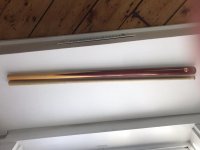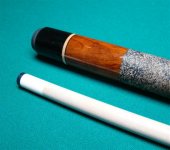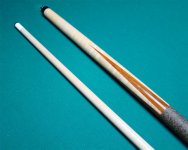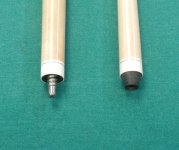I have posted in "ask the cue maker" for technical opinions- but would also like some player opinions on this: Doing a conversion of a 19 0z Old red leaf one piece Dufferin with a straight and perfect 12.75MM shaft. Cue has already been cut in half- see photos.
My first choice on the joint for this true sneaky pete-no collars- is a 3/8 10 pin in butt and wood threads with no brass insert in shaft.
Question is will cue play as solid with this 3/8 10 set-up as it would with a smaller pin such as 5/16 in butt with a brass insert in the shaft.
Second question is - any reason why the pin should be in the shaft as opposed to in the butt end? I have seen this set- up on some conversions and wondered why?
Presently own a Stenback sneaky with 3/8 10 pin in butt and wood threads in shaft and have no issues with the cue=plays solid. Appreciate for your experienced based opinions!
My first choice on the joint for this true sneaky pete-no collars- is a 3/8 10 pin in butt and wood threads with no brass insert in shaft.
Question is will cue play as solid with this 3/8 10 set-up as it would with a smaller pin such as 5/16 in butt with a brass insert in the shaft.
Second question is - any reason why the pin should be in the shaft as opposed to in the butt end? I have seen this set- up on some conversions and wondered why?
Presently own a Stenback sneaky with 3/8 10 pin in butt and wood threads in shaft and have no issues with the cue=plays solid. Appreciate for your experienced based opinions!






